Pieces of the puzzle: Teasing out the history of 1646 and Andover’s Town Seal, part 1
Every town and city in Massachusetts must have an official town seal. Images on many town seals are under scrutiny. Andover's town seal is among those being evaluated.
Welcome or welcome back to History Buzz. If you’re a subscriber to the Buzz, thank you! If you’re new here, or you haven’t become a subscriber yet, please sign up for a subscription to have History Buzz delivered directly to your inbox. If you can, please consider a paid subscription to support the research and writing that make History Buzz possible.
In 2021, the Town of Andover formed the Town Seal Review Committee to explore whether to keep or change the official town seal. A representative of the Andover Center for History and Culture was appointed to the committee to provide historical information and context.
Over the next few Mondays, we’ll share the evolution of Andover’s Town Seal over the past 168 years. Then we’ll take a dive into the history of Andover’s founding in 1646, as it relates to the image on the current seal. Along the way, we’ll look at the purpose and history of official town and state seals.
Some of these posts are excerpted from talks given by History Center Executive Director Elaine Clement, and by Denise and Paul Pouliot, leaders of the Cowasuck Band of the Pennacook-Abenaki, at an Andover community forum, September 21, 2022. You can watch the forum on the AndoverTV website.

History of Andover Town Seal images
After the 1855 separation of the original town into two separate communities - Andover and North Andover - this seal was adopted for official Andover town documents. The original town seal used on all official documents from about 1855 to 1900.
In 1896, the two Andovers celebrated the 250th anniversary of the founding of the original English settlement of Andover.
To commemorate the occasion, Andover jeweler John E. Whiting designed a hand-painted enamel souvenir pin. Whiting explained that his design was a current (1896) view of Andover. Whiting’s image depicted Cutchamache, a Massachuset sagamore, wearing what resembles a headdress more common to Great Plains Native people. The shirtless figure stands on Indian Ridge pointing at the town and the anniversary banner. He holds a coat and a bag marked 6£, the amount stated in Massachusetts court documents that he accepted as payment for the land then known as Cochichawicke.
The presence of the figure, Cutchamache, was based on a 1646 Massachusetts Court document that we’ll dive into in an upcoming post. The late 19th century illustration based on the 1896 souvenir pin is at the heart of Andover’s town seal review.
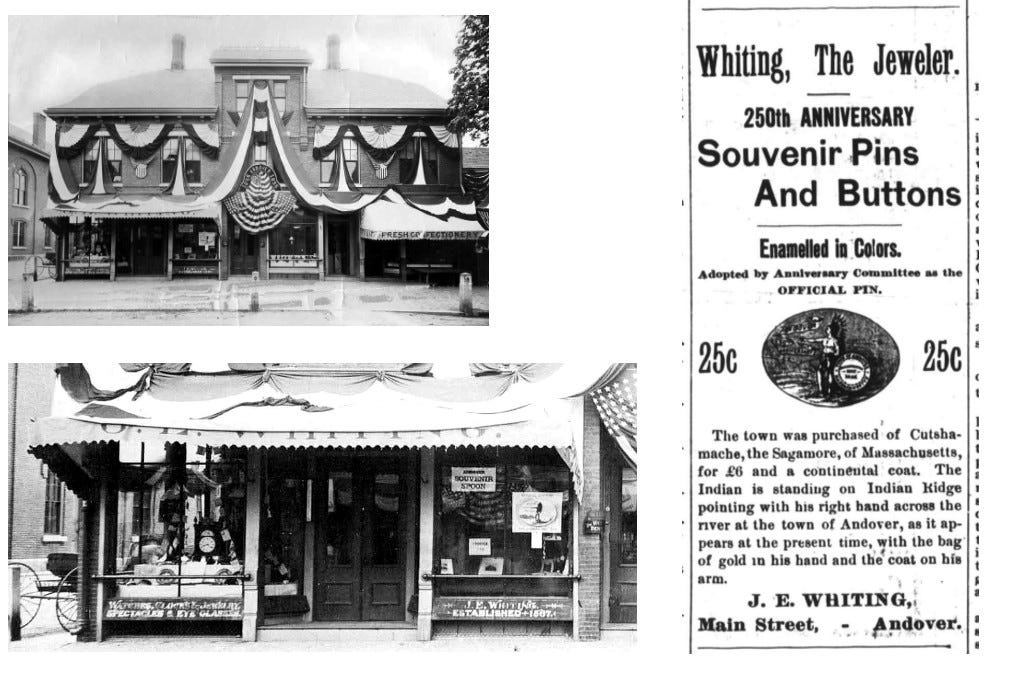
Whiting’s image is a reflection of westward expansion of the United States.
The Indigenous people of the Andover area had not disappeared, but they were - as a culture and as a people - disregarded by the general population. As a result, they were not visible and widely considered nonexistent. That was then, and now, incorrect. Native people have lived here for thousands of years, and continue to live here today, working to preserve their culture, heritage, and history.
The images of Indigenous people that 19th century east coast residents would have seen were of Great Plains tribes.1
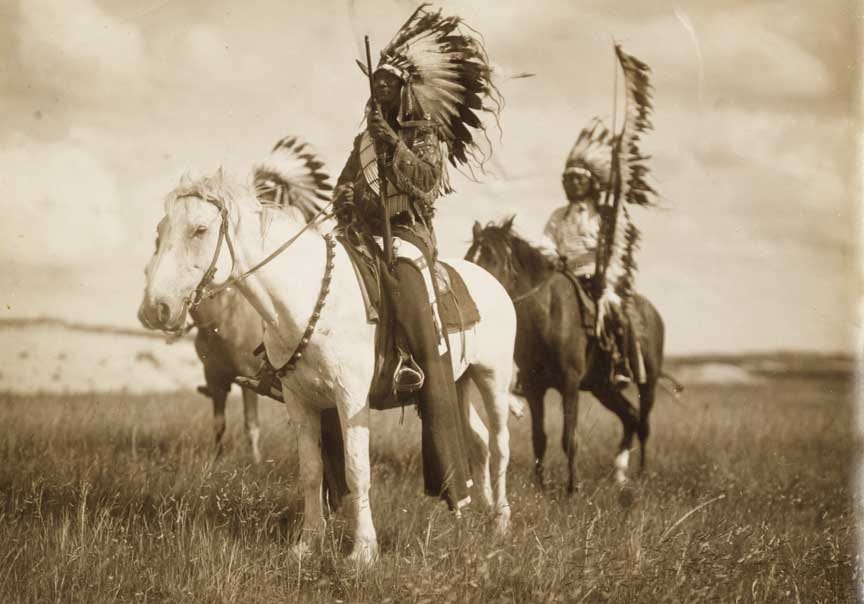
It’s at this time, the late 19th century, that we start to see images of Native people wearing Plains headdresses on town seals, promotional materials, advertisements, and as school logos and sports mascots.
As a hometown sports example, Andover was home to a professional soccer team, the Shawsheen Indians, that held the U.S. championship in 1924-1925.
Andover’s town seal is a direct reflection of this trend. This imagery was adopted by the town for the 250th anniversary and later for the town seal.

1900 town seal adopted at Town Meeting
In 1900 the State of Massachusetts required all cities and towns in the Commonwealth to have an official town seal. If a town had one already, the community could continue to use it. Or they could create a new one, as Andover did.
The first pictorial town seal was officially adopted at Town Meeting on March 5, 1900. It was designed by 13-year-old Andover native William Harnden Foster (who became a well-known artist as an adult).
Young William took the Whiting design of 1896 and incorporated it into the existing town seal. He added the date of May 6th and increased the size of the hills. The 6£ is now missing on the bag of money. The shirtless figure still wears an interpretation of a Plains headdress.
This logo appears on the Town Reports from 1901–1905.
1906 Town Seal redesigned
In 1906, the seal was redesigned by Leonard D. Sherman, a local photographer of artistic compositions. In this version, the figure is more muscular and bare-chested. The coat is longer and the river is still pond-like. The figure is once again wearing a Plains headdress bonnet, and the hills have changed size again.
1951 Town Seal redesigned, again
1951 brought the next transition of the seal with the publication of Town and City Seals of Massachusetts Vol. II. This version of the seal has been attributed to Miss Ethel Coolidge.
The 1951 version incorporates elements from both the Foster and Sherman seals. The figure, headdress, coat and clothing mirror Foster’s design, while the background resembles Sherman’s design. The figure has been described as resembling a real estate agent showing a client the land. This version of the town seal is still used today.
1965 version created for use on town vehicles
In 1965, a version of the town seal was created by the design department of the 3M Company for use on Andover’s official town vehicles. The New England hills have become the Western Rockies and the river more like a lake. The Plains Indian headdress bonnet design of Sherman has reappeared. The coat looks more like a blanket and the £ 6 has been added again. The unfortunate and inappropriate color red was added to the figure.

1996 Painting created for Andover's 350th anniversary
The 1996 version was created by Andover High School senior Kristoffel Meulan.
Meulan’s version was intended to represent a more accurate depiction of the traditional dress of the Native people of the region. However closer the headdress is to what was traditionally worn, the bare chest is far from accurate.2
The artist’s inspiration was taken from the original banner and the Whiting design. The ribbons were adapted to include the towns 350th, the original name of the town, and the name Cutshamache, who sold the land to the settlers for six English pounds and a Continental coat. The Town’s colors of blue and gold were worked into the design as they were in 1896. It was presented to the town Selectboard in August 1995, and hangs in the Selectboard’s meeting room.
The conversation about Andover’s Town Seal is ongoing. You can follow the work of the Town Seal Review Committee on the town website. For more information, you can watch the community forum that took place in September 2022. I also encourage readers to explore the history and culture of the Pennacook-Abenaki people on their website.
I’ll continue the series over the coming weeks with an exploration of the history of 1646, Cutchamache, and more.
Thank you for reading! Please share your thoughts and questions by leaving a comment. I love to hear from History Buzz readers.
~Elaine
https://www.historycentral.com/Indians/GreatPlains.html
https://www.cowasuck.org/





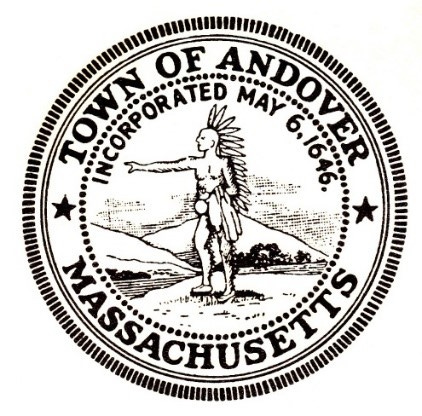
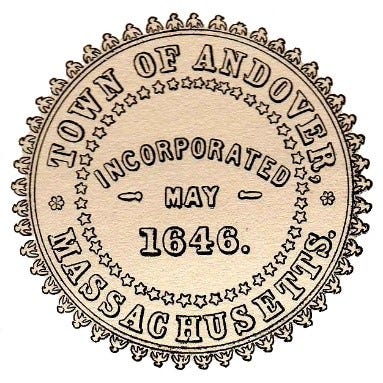

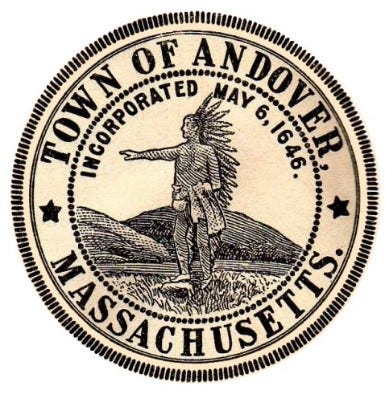
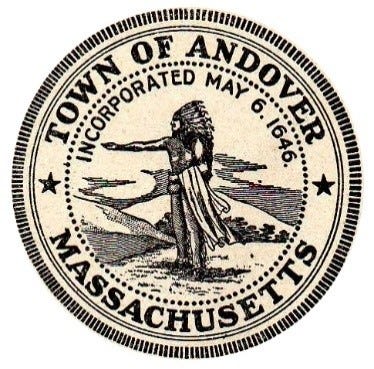

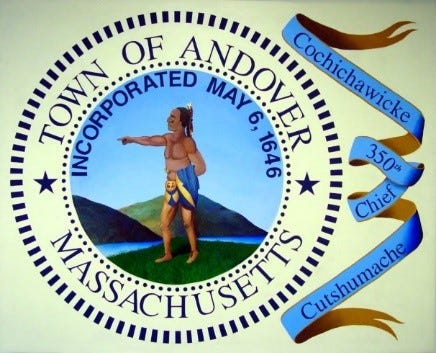

Thanks for an informative blog post on the town seal. The seal should reflect the history of this region and this region's indigenous residents. I will look for that forum on Andover TV.
Great post, Elaine! Thanks for sharing this important information. I especially like that you posted the image of the Abenaki people for reference. Thank you.